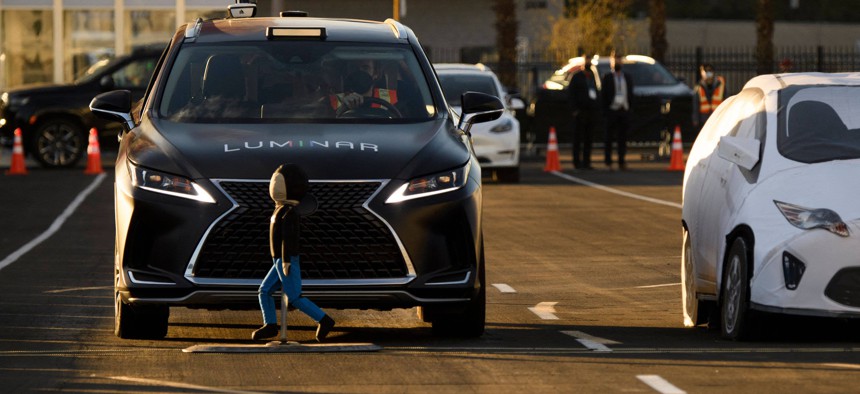NHTSA Proposes a Pass-Fail Pedestrian Safety Rating for Vehicles

Patrick T. Fallon/AFP via Getty Images
The scheme put forward by the National Highway Transportation Safety Administration comes as pedestrian deaths are surging nationwide.
The Biden administration has proposed rating new cars based on how well they protect pedestrians in the event of a crash—a feature that advocates for cyclists and pedestrians, along with many city officials, have long sought.
But the scheme put forward by the National Highway Transportation Safety Administration falls short of what many of those advocates had proposed. A vehicle’s safety for pedestrians would not be factored into the government’s five-star rating system. Instead, vehicles would get a separate pass or fail designation for pedestrian safety.
The agency explained that it would use the pass-fail system while it worked on overhauling the entire five-star rating scheme, which safety advocates have criticized as being too lax. “In the meantime,” the agency explained, “NHTSA believes that the proposal in this notice would provide consumers with valuable information and continue to incentivize vehicle safety improvements to help protect pedestrians.”
NHTSA’s proposal is certainly a breakthrough for safety advocates, who have blamed automakers for selling bigger and more powerful vehicles that keep their occupants safe but endanger other road users. Annual pedestrian deaths have increased by 37% in the two decades leading up to 2020, even as deaths of people inside vehicles declined.
“Ensuring the safety of pedestrians is a top priority at [the Department of Transportation], and these proposed updates to [the New Car Assessment Program] are an important step in addressing the crisis of roadway deaths in America,” said NHTSA Chief Counsel Ann Carlson in a statement. “Vehicles must be designed to protect their occupants while increasing safety for those outside the vehicle, too.”
As part of the 2021 infrastructure law, Congress required NHTSA to establish a way to inform consumers and the public about “pedestrian, bicyclist or other vulnerable road user safety technologies.”
But advocates worry that federal regulators aren’t moving quickly enough to identify those tools.
NHTSA is a notoriously slow-moving agency, and it spent most of the last six years without a Senate-confirmed leader. In fact, the actions announced this week are a follow-up to a process it started in 2015, late in the Obama administration.
“Pedestrian deaths have been rising. Cars have been getting larger and more dangerous with their blunt front ends and low visibility from the driver’s seat. And this needs to be regulated,” said Mike McGinn, the executive director of America Walks, a pedestrian advocacy group. “So it’s positive that this administration and [Transportation] Secretary Pete [Buttigieg] are looking at the safety ratings for people outside cars, not just inside cars.”
“It’s an important step, but we really need to go much further than proposed. We need more than just incentives for auto manufacturers to make safer vehicles. This should really be in our safety standards, just like airbags and seatbelts. Cars should be designed to be safer for pedestrians,” he added.
The agency said it plans to mandate features such as pedestrian automatic emergency braking in all new vehicles less than 8,500 pounds.
McGinn also said he was concerned about an aspect of the proposal that would only post the pedestrian safety ratings on NHTSA’s website, and not on the vehicle with other details about the vehicle.
“However NHTSA measures vehicle safety for pedestrians, it should be shared at the point of sale, not buried in a government website,” he said.
The tests that NHTSA plans to use to evaluate a vehicle’s safety for pedestrians are similar to tests already used for vehicles in Europe.
“The pedestrian protection testing evaluates the potential risk of head, pelvis, leg and knee injuries to pedestrians hit by the front of vehicles that result in impacts between the pedestrian and the bumper, leading edge, hood and windshield of a vehicle,” the agency explained. “A vehicle that scores well in these tests will likely utilize designs that absorb energy, reduce hard points of contact, and include front end shapes that would cause less harm (i.e., injuries) to a pedestrian if a vehicle hits that pedestrian.”
NHTSA will accept comments on its proposal for 60 days once the proposal is posted on regulations.gov.
Daniel C. Vock is a senior reporter for Route Fifty based in Washington, D.C.
NEXT STORY: County’s integrated platform delivers client-focused social services






